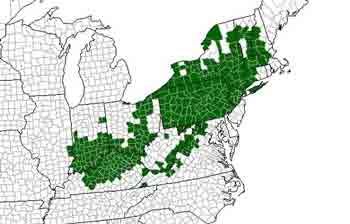
Jefferson Salamander
(Ambystoma jeffersonianum)
 |
 |
|
|
Distribution of the Jefferson Salamander (from the AR MI Atlas)
|
An adult Jefferson Salamander.
|
|
Description: a long, slender, gray to brownish-gray salamander with varying amounts of bluish flecks along the sides of the body. Other useful characteristics for identification include the relatively long head and a tail that is laterally compressed and nearly as long as the body (3-4”). |
||
Distribution in Ohio: Southern Ohio north through a narrow band of counties stretching to northeastern Ohio. Genetic material from this species has been found in unisexual salamanders throughout the state. |
||
|
|
||
Status in Ohio: The Jefferson Salamander is not a state listed species. |
||
|
|
||
Habitat: The Jefferson Salamander utilizes woodland vernal pools for breeding. Outside of the breeding season, adults live in underground burrows or under logs or other debris on the moist forest floor. |
||
|
|
||
Life history: Courtship, breeding, and egg-laying all occur underwater. Migrations of Jefferson Salamanders occur as early as late December or early January in southern Ohio, with individuals being observed courting underneath layers of ice. Egg masses containing 20-30 eggs are attached to fallen tree branches or other underwater structures. Time of hatching depends on water temperature and ranges from a couple of weeks to a couple of months after egg-laying. The aquatic larvae complete metamorphosis in 2-3 months. Sexual maturity is reached in 3 or more years. |
||
|
|
||
Conservation: The Jefferson Salamander relies on vernal pools for breeding and adjacent forested habitat for their adult life. Threats to this species include wetland filling and draining, introduction of fish to breeding ponds, pollutants, such as insecticides and herbicides, and loss of adult habitat. |
||
Last modified:
|
Ohio Amphibians · Ohio Salamander Web · Ohio Salamander Species · Amphibian Habitats · Salamander Monitoring |
|